Contents
Market Overview
Macro Review
When everyone becomes a U.S. rates trader. Market participants were closely following U.S. CPI along with UST auctions across the 3yr, 10yr and 30yr tenors this week. Instead, the rates market was driven wider after Verizon issued $25bn via nine tranches which is largest U.S. IG deal in 2021 and seventh largest in history. Rates edged wider as investor hedging activity struck when liquidity was particularly low. The second bout of volatility came in overnight trading with a large futures trade that re-priced U.S. Treasuries 6-8 bps wider. We may well see 5yr breakevens at 13yr wides, but we are not seeing broader market weakness. The dollar was only 30 bps weaker on the week which allowed JPY to climb above 109, the VIX was relatively quiet and notched down to 22, copper recovered 1.7% and oil was largely unchanged as equities rallied. The backdrop saw equities flourish by 4.5-5.0% over the past five sessions and the S&P remains above 3900. Little was new from the ECB other than growth expectations for 2021 were revised to 4% (up from 3.9%) and inflation to 1.5% (from 1.0%), while Lagarde stated that purchases under the PEPP envelope would be conducted at a “significantly higher pace”. This statement saw German bunds and Italian BTPs rally, meaning that the UST-DBR differential rose to 190 bps. Markets were focused on event risk and seemed to ignore vaccine trade war developments with the UK vs. EU, Italy vs. Australia, EU vs. AZN and now EU vs. U.S.
EM Credit Update
EM credit largely outperformed all other fixed income asset classes this week in spread. We started the week down but posted impressive gains midweek, only for the softness to return as U.S. Treasuries moved wider. EM sovereign credit ends the week 4 bps tighter, which puts returns up 0.5%. At the sovereign-level, Sri Lanka, Ecuador and Iraq outperformed this week, while Argentina, Honduras and Georgia lagged. We note that Lipper reported outflows in U.S. HY but also flag that large ETF inflows were not fully captured in the numbers. Stability in U.S. HY will be viewed as favorable for EM markets going forward, which should be closely followed in the weeks ahead.
The Week Ahead
All eyes will be on the FOMC followed by the BoJ next week, but rate decisions from Turkey (17.0%) and Brazil (2.0%) are very much live meetings. Market expectations for hikes are as high as 100 bps in Turkey (CBRT) and 50 bps in Brazil (Copom), however we also have meetings from Egypt (8.25%), Indonesia (3.50%), Russia (4.25%) and Taiwan (1.125%). The pressure on lifting lockdown restrictions is high across CEE economies, and the extent to which this has weighed on Polish unemployment and retail sales will become clearer. Restrictions remain tighter in the Czech Republic, where retail sales are expected to be lower as mobility data remains subdued. Otherwise, we can expect inflation prints out of Israel and Poland, with GDP out of Chile and Sri Lanka.
This week’s emerging markets highlights discussed below include the following: Lula’s unexpected political resurrection, China’s National People’s Congress and 14th Five Year Plan, South Africa’s 4Q growth and current account data, the $1.5bn FX swap line from China and how it impacts Sri Lanka’s ability to repay external debt and restructuring fears persist even in a higher growth world.
Fixed Income
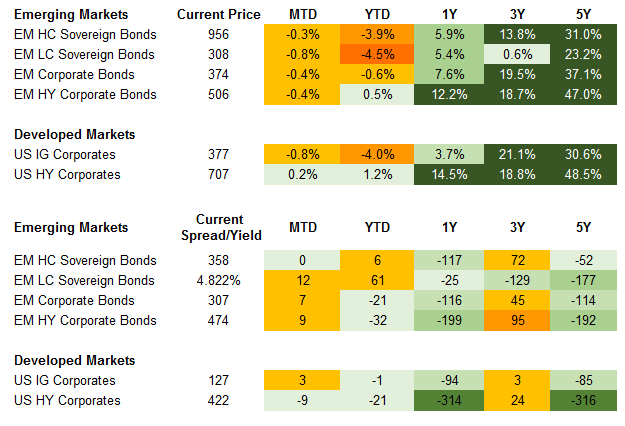
Equities
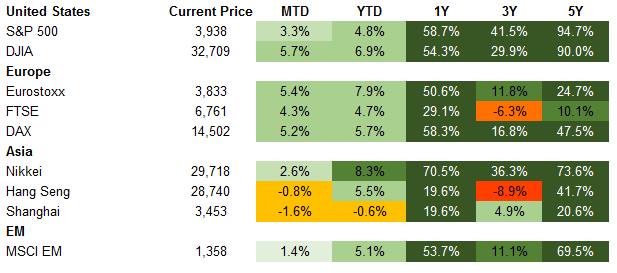
Commodities

Source for data tables: Bloomberg, JPMorgan, Gramercy. EM Fixed Income is represented by the following JPMorgan Indicies: EMBI Global, GBI-EM Global Diversified, CEMBI Broad Diversified and CEMBI Broad High Yield. DM Fixed Income is represented by the JPMorgan JULI Total Return Index and Domestic High Yield Index. Fixed Income, Equity and Commodity data is as of March 12, 2021 (Mid Afternoon).
Emerging Markets Weekly Highlights
Lula’s unexpected political resurrection adds to medium-term market concerns as Brazil faces fiscal, economic and public health challenges in the near-term
Event: A justice on Brazil’s Federal Supreme Court (STF) dismissed on technical grounds the two criminal convictions that former President Luiz Inacio Lula da Silva (Lula) received under the “Lava Jato” case. The decision means that Lula will most likely be eligible to run for President in the 2022 elections.
Gramercy Commentary: The news of Lula’s probable political comeback immediately sent shock waves across Brazilian markets as the former President, one of Latin America’s most iconic leftist figures, now seems likely to be the Workers Party (PT) candidate in the 2022 presidential elections. Lula’s potential run against right-wing current President, Jair Bolsonaro, likely sets Brazil up for a highly competitive race next year and elevated uncertainty over the medium-term economic outlook and fiscal trajectory. The latest political developments come amid sharp investor focus on the Bolsonaro Administration’s ability to navigate a confluence of near-term challenges related to fiscal adjustment and economic recovery in the context of a still accelerating pandemic in the country. While we believe that Bolsonaro’s actions are unlikely to shift further toward populism on the back of Lula’s political resurrection, we are watching closely for any signs that the President might be willing to push against the red lines of his Economy Minister, Paulo Guedes’, fiscal agenda. We remain of the view that a fallout between Bolsonaro and Guedes that would lead to the minister’s departure and could precipitate a crisis of market confidence is unlikely. We also expect Congress to pass, without material dilution, Guedes’ emergency fiscal reform package, which should support market confidence in the fiscal anchor. This being said, worsening pandemic dynamics pose the main risk to both the fiscal and economic trajectories, and, by extension, the political outlook. The still acute public health crisis in Brazil might undermine fiscal consolidation efforts as well as GDP recovery. Economic underperformance in the second half of the year might pressure Bolsonaro’s popularity, leading to more erratic behavior from the president and increasing the opposition’s electoral appeal already bolstered by Lula’s return to the main stage.
China’s National People’s Congress and 14th Five Year Plan point to gradual policy normalization
Event: The authorities set a growth floor of 6% for 2021, an official fiscal deficit target of 3.2% of GDP (vs. 3.6% of GDP 2020 target), and a CPI level of around 3% (vs. 3.5% 2020 target). M2 and TSF growth should be consistent with nominal GDP growth compared to 2020 levels which were calibrated to exceed 2019 levels. Dual circulation strategy, which aims to bolster supply chains and boost domestic demand, will drive greater technology research and development as well as other policies to support urbanization. Environmental related targets include a 13.5% per unit of GDP reduction in energy consumption, 18% reduction of C02 emissions per unit of GDP, and 0.9% increase in forest coverage cumulatively by 2025.
Gramercy Commentary: The targets and strategies outlined are generally in line with expectations for an incremental normalization of policy conditions amid solid economic growth. We envisage official real GDP growth to comfortably exceed the 6% floor at 7.5-8.5% this year. The renewed focus on financial stability, leverage, and overall growth composition and associated policies should result in roughly 2-3% of GDP narrowing in the augmented deficit as well as a roughly 2% point decline in credit growth. Rotation to a more consumer oriented economy will resume but at a very gradual pace as aging and rising household debt pose headwinds. In this context, we anticipate tighter property sector conditions and measures to persist albeit with mixed implications for developers. We remain most constructive on large cap developers that have strong relationships with local and state governments, diversification across geographies and products, greater exposure to T1 and upper-T2 cities, and balance sheet headroom that will allow for inorganic expansion opportunities as the industry consolidates.
South Africa 4Q growth and current account data reflect early cyclical recovery
Event: Real GDP growth in the fourth quarter beat expectations, contracting 4.1% YoY versus consensus estimates for a 4.6% drop. In real annualized QoQ terms, the economy expanded 6.3%. The secondary sector led by manufacturing fared the best with the tertiary sector still lagging. Full year real economic activity contracted 7%. The current account maintained a comfortable surplus of 3.7% of GDP in 4Q bringing the full year surplus to 2.2% of GDP. This compares to a deficit of 3.1% of GDP in 2019. Supportive terms of trade, particularly in 4Q, helped offset weaker export volumes throughout the year amid lockdowns.
Gramercy Commentary: The moderately smaller than expected growth contraction in 4Q should increase confidence that 2021 activity will reach or exceed the consensus estimate of around 3.5%. High frequency data has been soft in 1Q but there is indication of improving sentiment. However, GDP is not expected to reach 2019 levels until 2023 and structural constraints to growth are likely to persist given lack of material reform prospects. The current account surplus will gradually decline and shift back into deficit as consumption and imports recover more materially. The scale and pace of erosion relative to expectations will in part determine the impact on the currency as bouts of volatility associated with taper prospects in the U.S. continue. The consensus estimate is for a 0.4% of GDP deficit for 2021.
$1.5bn FX swap line from China improves Sri Lanka’s ability to repay external debt and gives the economy a longer runway to recover from the COVID-19 shock
Event: The authorities in Colombo announced on Wednesday that the People’s Bank of China (PBOC) has approved a $1.5bn swap facility, which will be available for Sri Lanka to draw down “as and when needed”.
Gramercy Commentary: This is a credit positive development that supports Sri Lanka’s efforts to repay in full and on time its external debt obligations amid significant FX liquidity pressures precipitated by the collapse in external demand due to the pandemic. Throughout the current crisis, the authorities have sent consistent and clear messages to capital markets on their strong willingness to repay debt. The confirmation of a FX swap line with China improves their ability to do so without imposing additional stringent limitations on domestic economic activity and imports that have already been curtailed significantly in order to preserve precious hard currency liquidity. It would also give the economy and its important tourism sector a longer period and better odds at recovering against a backdrop of lower sovereign default risk while awaiting external inflows to pick up as global economic activity returns to patterns that are more normal. In addition to the $1.5bn Chinese swap facility, Sri Lanka’s external liquidity buffer could be boosted by another ~$0.6bn if the potential increase in IMF SDRs (special drawing rights) materializes, which we think carries a good probability by mid-year. For context, the IMF issues SDRs to the central banks of its members as a reserve asset that they can easily exchange for hard currency at a low interest rate, usually < 1% per annum. By allowing on-demand access to freely usable hard currency, SDRs are most impactful for economies that face external liquidity pressures, such as Sri Lanka.
Global emerging markets corporates in focus: Don’t mention the ‘R’ word – Restructuring fears persist even in a higher growth world
Event: The OECD has revised its world GDP growth forecast for 2021 upwards by 1.4ppt to 5.6%. Significant revisions to growth forecasts were made for the U.S. and other developed markets. Emerging markets were not left out. India’s 2021 GDP growth forecast increased by 4.7ppt to 12.6% while Turkey’s is now 3ppt higher at 5.9%. Despite this, there are lingering concerns about the effects of the pandemic. Specifically, there are still concerns about a potential rise in restructurings or defaults.
Gramercy Commentary: It is possible to argue that we have seen a rise in defaults amongst corporates already. Some of these have been linked to restructuring negotiations by the relevant sovereigns; others have been driven by the impact of the pandemic on specific sectors such as hospitality and travel. Government and other interventions (such as loans from multilateral development banks) have helped more than a few corporates avoid the worst effects of the pandemic. Restructuring negotiations have also happened behind the scenes, with local lenders. The effects of these actions are evident on some banks’ balance sheets and help explain the significant increases in provisions recorded at many lenders last year. Having noted all this, some risks still remain. We have previously commented on the likelihood of greater differentiation between countries in emerging markets. This is likely to be the case within countries too – some industries and parts of the economy are likely to fare better than others, even where there is higher growth. As one example, the damage done by pandemic-related lockdowns and restrictions to high street retailers around the world has been well flagged. In addition, one rating agency recently highlighted lending to SMEs as an area of concern for banks in Latin America. Volatility in the U.S. Treasury market and the impact on bond yields in parts of our markets has contributed to some corporates delaying planned issuance. In some cases, fund raising may well have been purely opportunistic. As such, there may be no impact on the ability of such corporates to repay existing obligations. For other corporates, less-stable new issue markets are a real concern.
Emerging Markets Technicals
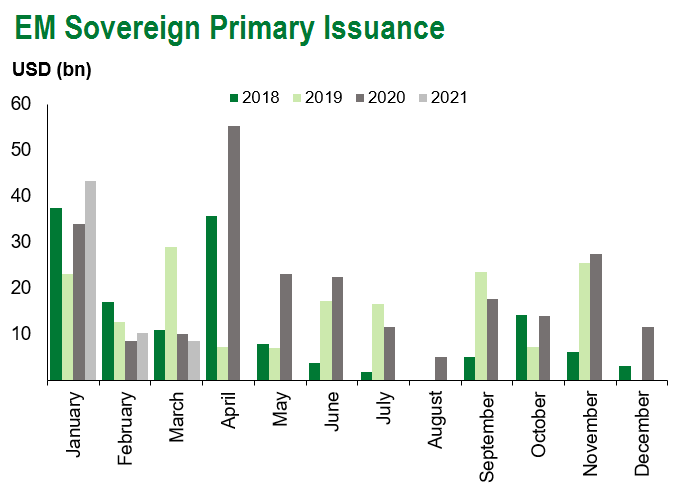
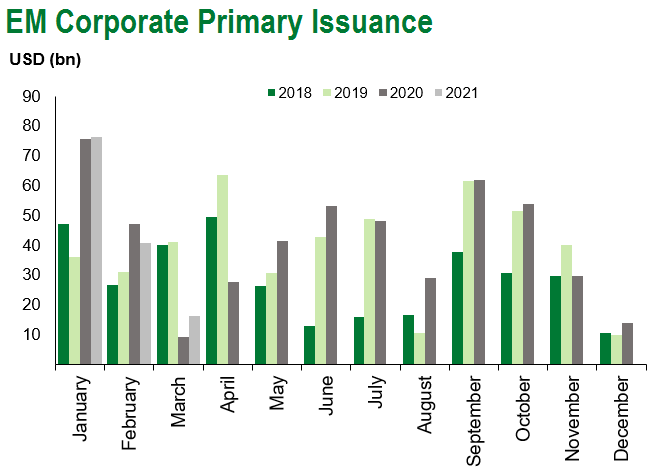
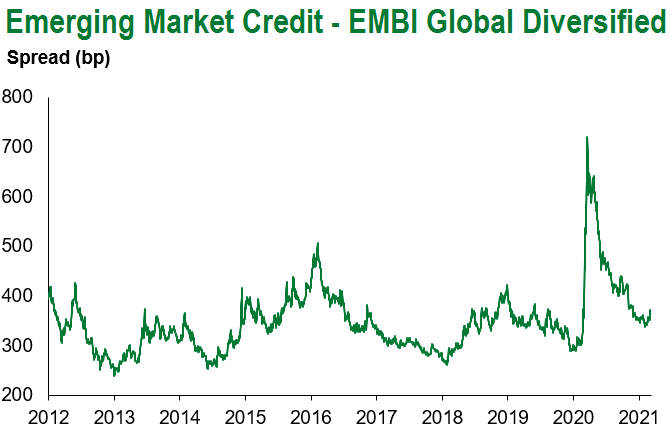
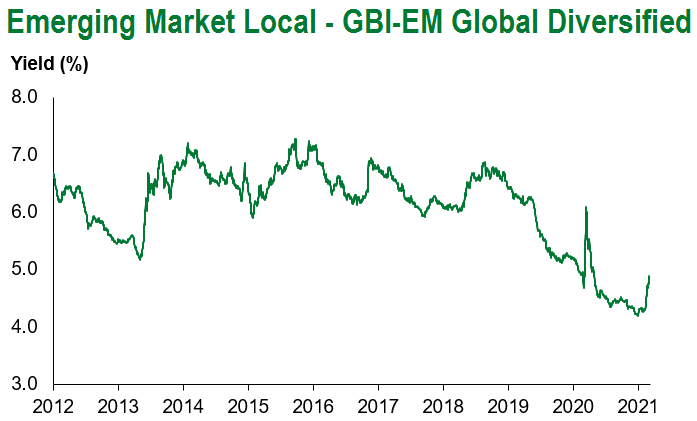
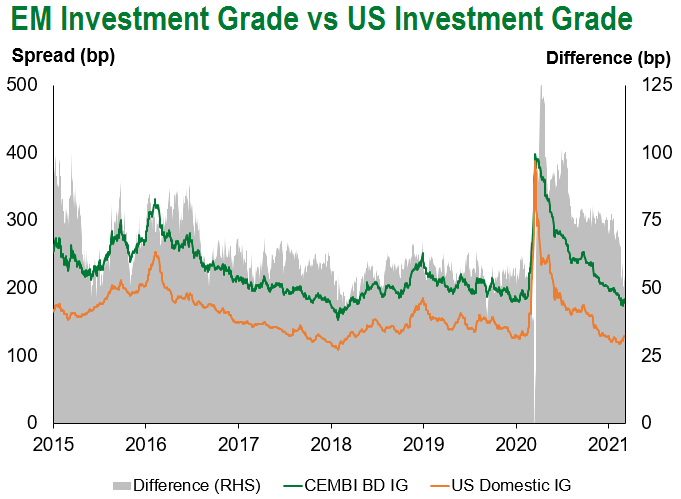
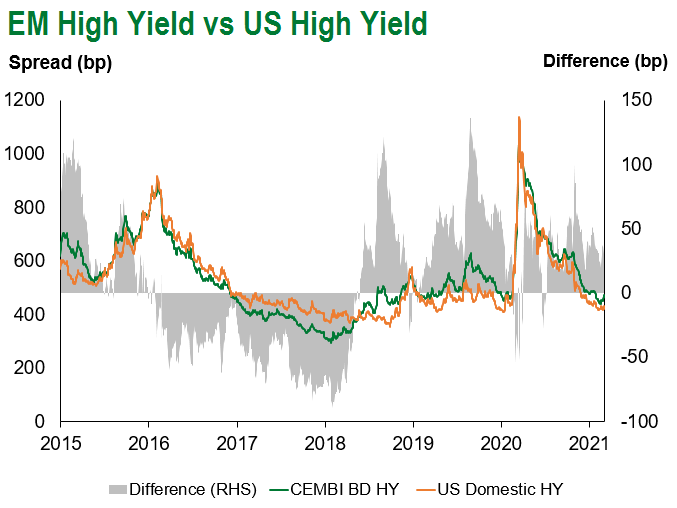

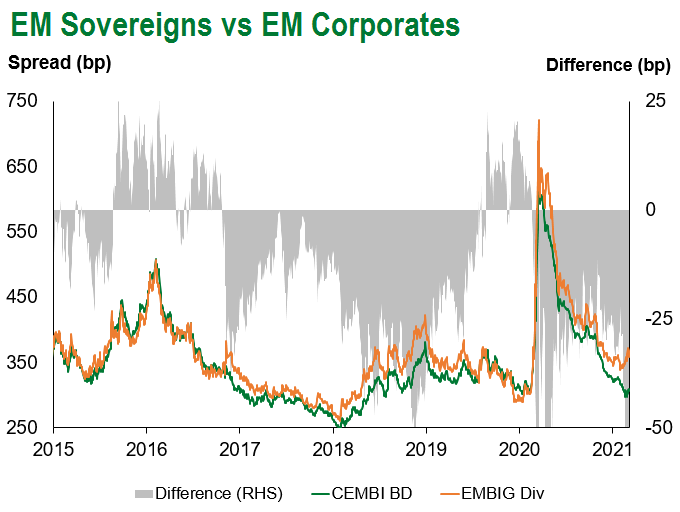
Emerging Markets Flows
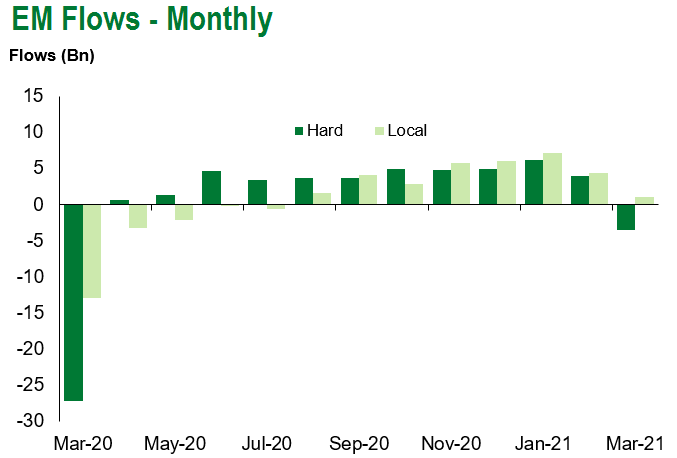
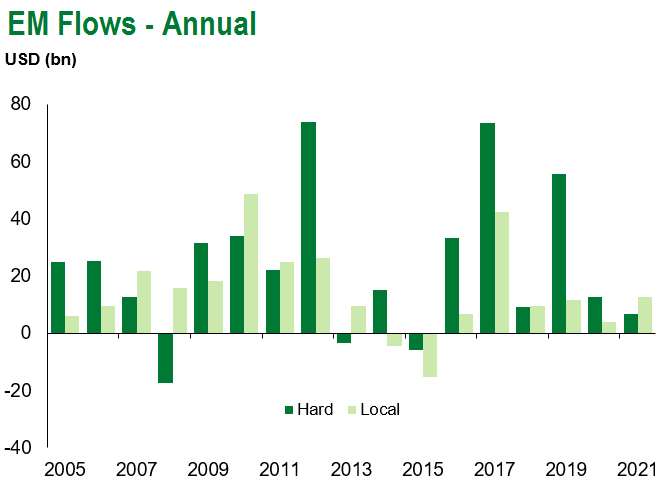
Source for graphs: Bloomberg, JPMorgan, Gramercy. As of March 12, 2021.
COVID Resources
Emerging Markets COVID-19 Case Summary
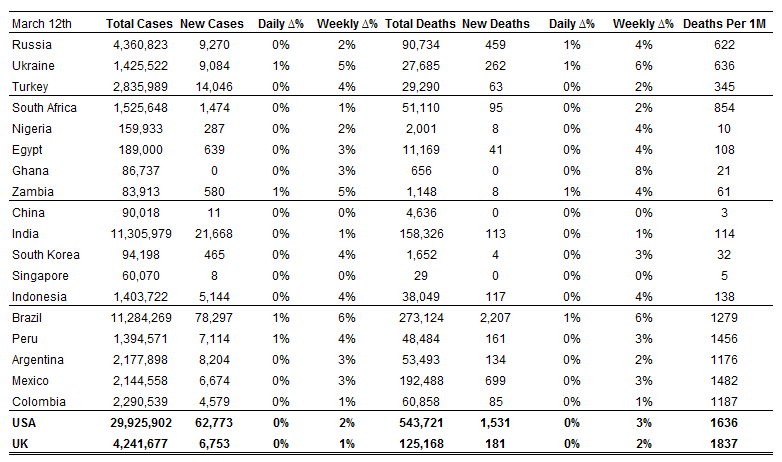
Source: Worldometer as of March 12, 2021.
Additional Crisis Resources:
Johns Hopkins COVID-19 Case Tracker
For questions, please contact:
Kathryn Exum, Senior Vice President, Sovereign Research Analyst, [email protected]
Petar Atanasov, Senior Vice President, Sovereign Research Analyst, [email protected]
Tolu Alamutu,CFA, Senior Vice President, Corporate Research Analyst, [email protected]
James Barry, Vice President, Corporate Research Analyst, [email protected]
This document is for informational purposes only. The information presented is not intended to be relied upon as a forecast, research or investment advice, and is not a recommendation, offer or solicitation to buy or sell any securities or to adopt any investment strategy. Gramercy may have current investment positions in the securities or sovereigns mentioned above. The information and opinions contained in this paper are as of the date of initial publication, derived from proprietary and nonproprietary sources deemed by Gramercy to be reliable, are not necessarily all-inclusive and are not guaranteed as to accuracy. This paper may contain “forward-looking” information that is not purely historical in nature. Such information may include, among other things, projections and forecasts. There is no guarantee that any forecasts made will come to pass. Reliance upon information in this paper is at the sole discretion of the reader. You should not rely on this presentation as the basis upon which to make an investment decision. Investment involves risk. There can be no assurance that investment objectives will be achieved. Investors must be prepared to bear the risk of a total loss of their investment. These risks are often heightened for investments in emerging/developing markets or smaller capital markets. International investing involves risks, including risks related to foreign currency, limited liquidity, less government regulation, and the possibility of substantial volatility due to adverse political, economic or other developments. The information provided herein is neither tax nor legal advice. Investors should speak to their tax professional for specific information regarding their tax situation.